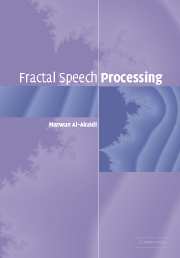Book contents
- Frontmatter
- Contents
- List of acronyms and abbreviations
- 1 Introduction to speech processing
- 2 Computational background
- 3 Statistical analysis, entropy and Bayesian estimation
- 4 Introduction to fractal geometry
- 5 Application to speech processing and synthesis
- 6 Speech processing with fractals
- 7 Speech synthesis using fractals
- 8 Cryptology and chaos
- Index
7 - Speech synthesis using fractals
- Frontmatter
- Contents
- List of acronyms and abbreviations
- 1 Introduction to speech processing
- 2 Computational background
- 3 Statistical analysis, entropy and Bayesian estimation
- 4 Introduction to fractal geometry
- 5 Application to speech processing and synthesis
- 6 Speech processing with fractals
- 7 Speech synthesis using fractals
- 8 Cryptology and chaos
- Index
Summary
Computing fractal noise
Developing mathematical models to simulate and analyse noise has an important role in digital signal and image processing. Computer generated noise is routinely used to test the robustness of different types of algorithm; it is used for data encryption and even to enhance or amplify signals through ‘stochastic resonance’. Accurate statistical models for noise (e.g. the probability density function or the characteristic function) are particularly important in image restoration using Bayesian estimation [1], maximum-entropy methods for signal and image reconstruction [2] and in the image segmentation of coherent images in which ‘speckle’ (arguably a special type of noise, i.e. coherent Gaussian noise) is a prominent feature [3]. The noise characteristics of a given imaging system often dictate the type of filters that are used to process and analyse the data. Noise simulation is also important in the synthesis of images used in computer graphics and computer animation systems, in which fractal noise has a special place (e.g. [4, 5]).
The application of fractal geometry for modelling naturally occurring signals and images is well known. This is due to the fact that the ‘statistics’ and spectral characteristics of random scaling fractals are consistent with many objects found in nature, a characteristic that is expressed in the term ‘statistical self-affinity’. This term refers to random processes whose statistics are scale invariant. An RSF signal is one whose PDF remains the same irrespective of the scale over which the signal is sampled.
- Type
- Chapter
- Information
- Fractal Speech Processing , pp. 164 - 177Publisher: Cambridge University PressPrint publication year: 2004



